Talk with our local travel specialist who can help organize your trip.
How difficult is Mera Peak Climb?
Mera Peak is a trekking peak in Nepal's Hinku Valley of the Solu Khumbu region in the northeast. Mera Peak at the height of 6,476 m is often considered the highest trekking peak in Nepal. Summiting the mighty peak is regarded to be a slightly difficult climb due to the high altitude. However, most of the route is non-technical and straightforward. Mera Peak is a range of three major summits, including Mera North (6,476m), Mera Central (6,461m), and Mera South (6,065m), of which Mera North is the most popular among climbers. The peak is straddled between the off-beat path of the Hinku and Hongo river valleys on the west and east, respectively.
In the early 1950s, Mera Peak was already explored by the popular British expeditions team consisting of Edmund Hillary and Tenzing Norgay. However, Mera Central was first climbed and ascended by Col. Jimmy Roberts and Sen Tenzing in 1953, while Mera North was first ascended by Marcel Baus and L. Honills in 1975. The peak has since gained high popularity among movie and experienced climbers as you can see Mt. Everest and other eight-thousanders mountains from the summit.
Mera Peak has been deemed a slightly difficult climbing peak according to alpine grade standards due to the changes in the glacial structures in recent days. It is best suited for first-time climbers who have had experience in high altitude climbing and are physically fit.
Table of Content
- Major Highlights of Mera Peak Climbing
- How to get to Mera Peak
- Mera Peak Climbing Duration
- Best time to Climb Mera Peak
- Weather Condition
- Clothing & Equipment
- Accommodations, Food and Water
- Mera Peak Climbing Permits
- Preparations for Mera Peak Climb
- Previous experience needed to climb Mera peak
- Altitude Sickness
- Travel Insurance and Emergency Medical Rescue
- Can I Climb Mera Peak?
- Tips To Summit Mera Peak
- Conclusion
Major Highlights of Mera Peak Climbing
- Experience of acclaiming one of the highest trekking peaks in Nepal at an altitude of 6476m
- Witness the mesmerizing views of five of the highest eight-thousander mountains of the world, including Mt. Everest, Kanchenjunga, Lhotse, Makalu, and Cho Oyu.
- Walk past many glacial lakes, waterfalls, icy glaciers towards the summit
- Experience the nomadic lifestyle of the yak herders along the isolated Hinku valley
- Visit ancient Buddhist shrines and intermingle with Tibetan Buddhist Sherpa's to witness their traditions and culture.
- Chance of witnessing red panda, snow leopard, Himalayan Thar, and other rare wildlife in the Makalu Barun National Park along the trail
How to get to Mera Peak
There are two major ways of getting to Mera Peak after reaching Lukla in the Solu Khumbu region. There are two diversions in the initial phase of the trek after Lukla; you can take the easier yet, the longer approach or, the shorter and tougher one. After the initial 4 to 5 days, the rest of the trekking trail follows the same route.
1. Fly from Kathmandu to Lukla
After arriving in the capital city of Nepal, Kathmandu, you can take an adventurous flight northeast to Lukla from Kathmandu, the gateway to the Everest region. The flight from Kathmandu domestic airport to Tenzing Hillary Airport in Lukla will take 35 minutes.
2. Trek from Lukla to Kothe
Once you reach Lukla, instead of heading north to Namche Bazaar, you will head east to the ridge of the peaks separating Dudh Koshi from Hinku Valley. From Lukla, there are two approaches that you can choose from.
You can head to Chutanga then to Thuli Kharka by crossing the Zatrwa La (4600m/15092ft) pass. From Thuli Kharka, the next stop is Kothe village in the Upper Hinku valley. This route is challenging as it involves crossing a high altitude pass in the first few days of the trek without proper acclimatization. However, this route to Kothe is quicker and saves 3-4 extra days.
Another option is a much easier yet longer one, which involves taking a longer route to reach Kothe—from there, exploring the Makalu Barun National Park, head to Chatra Khola river, then finally to Kothe. Although a longer route, you will not have to cross a high altitude pass in the initial days, making it easier.
3. Kothe to Mera High Camp
From Kothe village, there is only one major trail leading to Mera Peak summit. The trail heads north to Thaknak and further up north till Khare (5,045m), which requires a momentary stop for a day's acclimatization. From there, the summit is south, so you begin your glacial walk to Mera Base Camp and Mera High Camp for a stop. Stopping at High camp for the night is beneficial for the majestic views of the mountains and acclimatization.
4. Summit Mera Peak
From Mera High Camp, the immediate next destination is the summit of Mera Peak. You start the climb even before dawn at around 2 AM. Crossing Mera glacier along the steep incline of the slope, then 40-50 meters ahead, you will reach the summit. Finally, after the challenging climb, you are left in astonishment by the views of the tallest mountains scattered before you. The two other summits of Mera Peak surround the towering Mera North.
Mera Peak Climbing Duration
Mera Peak Climbing expedition is 14 to 18 days long, depending upon the route that is taken. If you take the route from Zatrwa La, it takes close to 14 days, but if you take the longer route crossing Pankongma La pass, it takes around 18 days. There is a difference of about 3-4 days in the long trail where you will cross the lower altitude villages in between to acclimatize with the rising altitude.
Mera Peak climbing from the High Camp to the summit takes about 8 hours long. If you start at around 2 AM, then you will reach the summit at around 10 AM. You will take small steps and walk slowly to reach the summit to avoid getting altitude sickness or having any mishaps on the steep slopes.
Featured Trips
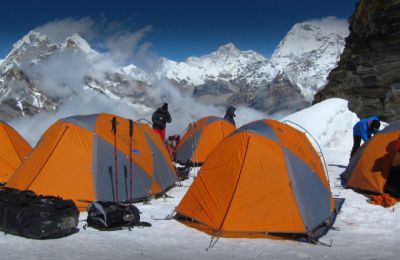
Mera Peak Climbing - 18 days
Mera Peak is a high-altitude, fascinating climbing peak in the Solu Khumbu region of Nepal. Mera Peak Climbing is an easy, non-technical climb, ideal for novice climbers who wish to climb their first mountain in Nepal and best for professional as well as non-experienced climbers.
Inquire Now
Mera Peak Climbing Itinerary - 14 days
Mera Peak Climbing Itinerary of 14 days led by a Sherpa climbing guide with 20 plus years of climbing experience. You will safely make it to the summit in just 2 weeks.
Inquire NowWhere to travel next?
Get help from our travel specialists for holiday ideas that matches your interests.
Best time to Climb Mera Peak
The best time to climb Mera Peak in Nepal in late April, May, Late September, October, and November. Late April and May fall in Spring when the weather is dry, the rhododendron and wildflowers bloom, and you can observe the best mountain views under the clear blue sky.
Late September, October, and November fall in the Autumn season when the wet monsoon season has just ended, and the sky is crystal clear, offering impeccable views. Moreover, the sunrise and sunset views in the Himalayas during Autumn are mesmerizing. Both the Spring and Autumn seasons are popular for peak climbing in Nepal and particularly good for Mera Peak climbing.
The Winter season is not recommended for climbing Mera Peak because most of the trail will be covered with snow at a higher altitude, and the slopes will be snowy and slippery. The monsoon season is also not the best season for climbing because trekking in the low land during the pouring rain means the possibilities of landslides, slippery and muddy trails, and lack of visibility. Hence, both winter and monsoon seasons should be avoided for Mera Peak climbing.
Weather Condition
The weather conditions in the Himalayas of Nepal are ever-changing and almost unpredictable, particularly during the off-seasons of Winter and Monsoon. Weather conditions on the Mera Peak climbing trail vary based on the season of travel and changing altitude.
In Autumn, the average temperature during the day is 12 degrees Celsius and may drop to 6 degrees Celsius at night. In the low land villages of the trail, the climate is neither too hot nor too cold, but as the elevation rises, you would require warm insulated clothes to combat the cold air. In November, there might also be chances of light snowfall.
During the spring season, the weather is dry and clean, and the temperature can go to an average of 10 degrees Celsius during the day and up to -4 degrees celsius at night. From March, the temperature in the Mera peak trail increases gradually, which starts to melt the snow and makes it perfect around late April.
The monsoon season, also called wet summer, sees frequent rainfall at low altitudes and snowfall at high camps. The average temperature during the day is around 15 degrees Celsius, and the temperature drops slightly with rainfall or snowfall.
During winter, the weather condition is harsh, with huge piles of thick snow in the trail towards the summit. The temperature can drop to an average of - 30 degrees Celsius above the base camp with high snowy winds. Climbing during these conditions is risky and not recommended.
Clothing & Equipment
Going above 6000m for an exhilarating climb most certainly requires the right kind of clothing and gears. As Mera Peak is one of the highest trekking peaks, the weather at the high altitude is cold and snowy most times of the year. To combat the weather conditions and harsh topography, you need to pack the items with care.
Below are the crucial items of clothing and equipment /packing for Mera Peak climbing:
1. Clothing
Head: Carry a warm woolen hat that covers your ears, a neck gaiter, headlamps for an early morning climb, and snow goggles to protect against snow blindness.
Upper Body: Pack 2-3 moisture-absorbing long sleeve shirts, 3-4 T-shirts, Thermal base layer, fleece jackets, a down jacket with hood.
Hands: Make sure that you carry a pair of Lightweight ply liner gloves and a pair of insulated summit mittens with safety straps.
Lower Body: Non-cotton underwear, thermal leggings, hardshell trousers, trekking pants, and waterproof trousers are essential.
Feet: Having the best shoe is important during high-altitude treks and peak climbing. You need sturdy trekking boots with ankle support, double insulated climbing boots, 6-7 thick socks, flip flops to wear inside the tea house, crampons, and gaiters to protect shoes and low legs.
2. Travel and Sleeping gears
For all of the clothing and heavy equipment, you would require a large duffle bag of about 80L to 120 L, which the porters will carry. A 40L to 50L daypack containing all the essential items and expensive personal items can be carried by you. You can carry a five-season sleeping bag that can withstand about -30 degrees Celsius weather.
In addition, for travel, make sure to carry your items, medical supplies, and toiletries.
3. Personal climbing equipment
Mera Peak is a non-technical climb and easy, but you need to carry all the essential climbing equipment as they will have their respective use.
Carry properly insulated and comfortable climbing boots with semi-rigid crampons to make the climb easier. Infinity dry rope is necessary for Mera Peak as it is needed to anchor yourself on a rock and another hard surface. Ice axes will be used to cut ice during climbing, and ascenders will be used for steep and icy climbing surfaces. The harness is important to attach you to a rope anchored on the peak. Carry two locking carabiners, including one large and one small, with four regular carabiners to connect ropes and harness.
Also, carry a rappel device to control your belay, ski poles for support, and one 3m/10ft and three 2m/6 ft slings for the flexibility and low stretch during the climb. Furthermore, you can carry an altimeter watch to measure altitude, climbing helmets to protect your head from possible rocks or ice falls, oxygen cylinders in case of breathlessness.
Apart from the personal climbing gears, for the entire group, the travel company will manage some required climbing gears like tents, cooking gears and utensils, first aid, GPS, maps, compass, whistle, and more.
Accommodations, Food and Water
Accommodation facilities in Mera peak climbing involve staying at tea houses during the trek and setting up camps near the summit. The first days at Kathmandu is a pleasant experience as you get to stay at a hotel as per your preference and budget. The hotels are generally nice with all the required amenities like furniture, TV, hot water, free wifi, bar, restaurant, and more.
Then, as you enter the Solu Khumbu region, you will reside at tea houses owned by the locals during the trekking days. These tea houses are very modest, with only the basic furniture, a communal dining area, and a communal bathroom with a squat pan. As you move on to higher altitudes, the availability of even the necessities is rare. There may be power cuts; the wifi is to be paid for but getting a signal is tough. Some tea houses have twin shared bedrooms, bunk beds, and foam mattresses, a warm blanket, bedsheets, and a pillow.
Upon reaching Mera High Camp, the crew will set up the tented camp, where you will have to sleep for a night. The tents are small with a light flickering on top, and you will use your sleeping bag.
Food in the hotels of Kathmandu contains a variety of dishes from different cuisines around the world. From Lukla onwards till Khare, the tea houses offer decent food. Often they have freshly cooked staple Nepali meals of Lentil, boiled rice, and vegetable curry or Tibetan bread. Alternatively, you can also ask for some other dishes on the menu like oats, omelets, pizza, dumplings, and more. However, it is worth noting that these dishes are not ala carte but mediocre as bringing ingredients in these remote vehicle-less areas is tough. In the camps, the kitchen assistant will cook a decent meal with the ingredients, so there aren't any other food options other than what is served.
Clean drinking water in remote regions and higher altitudes is often difficult to find. You can find bottled water in some tea houses, but it is twice as expensive. Hence, you can carry a water purification tablet or filtering flask along with a water bottle and fill the water from the clean taps with running water. For hot water, you need to pay the tea house's owner, who will offer a pot of boiling water at a certain cost. It is essential to keep yourself hydrated during the trek.
Mera Peak Climbing Permits
Beyond the climbing permit required for peak climbing in Nepal, there are some other essential permits needed as you pass by certain regions on the trail. Following are the Mera peak climbing permits required:
1. Mera Peak Climbing Permit
This is the actual permit required to summit Mera Peak. The Nepal Mountaineering Association (NMA) issues it, and the price varies according to the season of travel. For the Spring season, the cost is up to USD 250; for Autumn, it is USD 125; and for the off-seasons of Winter and Monsoon, it is up to USD 70.
2. Khumbu Pasang Lhamu Rural Municipality Entrance Permit
This is a local area permit required as you enter the Khumbu region. The trekking trail to Mera Peak will pass through many villages of the Khumbu region. It can be collected from Lukla upon arrival and costs around USD 20.
3. Makalu Barun National Park Entry Permit
The Mera Peak trail is situated in the vast span of the Makalu Barun National park. This permit is issued to ensure the protection and preservation of exotic biodiversity. The permit can be collected from the authorized office in Kathmandu or Kothe and costs approximately USD 15 for SAARC nationals and USD 30 for other foreigners.
Besides these permits, if you plan to begin trekking from Jiri, you would require the Gaurishankar Conservation Area Project Entry Permit Fee, which costs about USD 20.
Before or after your summit, if you wish to take the route following the Everest Base Camp trail in the Sagarmatha National Park region, you will have to also get a Sagarmatha National Park Entry Permit. It costs about USD 15 for SAARC nationals and USD 30 for other foreigners.
While individual trekkers can get their trekking permits, only the government-registered trekking agencies can obtain the climbing permit. It is because the Mera peak climbing cannot be done without a guide. Moreover, all the peak climbing in Nepal cannot be done alone and can only be facilitated by these agencies for the safety of the tourists. Getting all of these permits might be a big hassle, but worry not like the travel agency in Nepal will make all the necessary arrangements for you.
Recommended Read: Climbing Permit Fee For Trekking Peaks In Nepal
Featured Trips
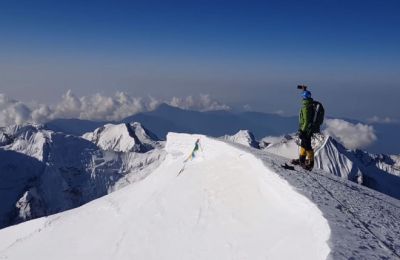
Mera Peak and Island Peak Climbing - 24 days
Mera Peak and Island Peak climbing is a trip to Nepal climb two peaks above 6000 meters in a single trip. Both Climbing adventure which lasts for 24 days will challenge you to the fullest.
Inquire Now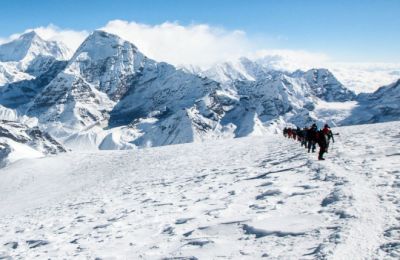
Mera Peak Climbing and Amphu Lapcha Pass - 21 days
Mera Peak Climbing and Amphu Lapcha Pass of 21 days is a combination of trekking and climbing adventure that takes you to the summit of Nepal's highest trekking peak.
Inquire Now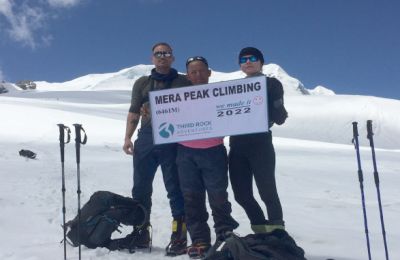
Mera Peak Expedition via Phaplu - 19 days
Mera Peak Expedition via Phaplu is an alternative route of driving to Phaplu and starting the trek from Khari Khola rather than flying directly to Lukla.
Inquire NowWhere to travel next?
Get help from our travel specialists for holiday ideas that matches your interests.
Preparations for Mera Peak Climb
The Mera Peak Climbing was previously noted to be an easy climb according to Alpine standards. Still, recently due to the changes in glacial structures, it has been graded as Alpine Grade PD, which means it is a slightly difficult climb. Mera Peak climbing is a non-technical climb, but that doesn't mean it is devoid of physical exertion. As peak climbing is an extreme outdoor activity, you would require ample preparation before taking on the climb.
As Mera Peak climbing is not easy, you need to make preparations for the climb at least 3 to 4 months before your travel date to Nepal. First and foremost, you need to do some research on your own about peak climbing in Nepal and particularly understand how difficult it is to climb Mera Peak. After understanding the requirements, you can begin with some basic physical exercises like cardio, lunges, squats, aerobics, shoulder presses, pull-ups, shoulder flies, cycling, swimming, and running. Hitting the gym will probably be the best way to get your daily dose of exercise.
As you will have to walk long hours in the trek, you need to have the stamina and endurance, for which you can be involved in some hiking activities each month or, better yet, go on a trekking adventure. Also, to maintain your fitness and stamina, it is best to be above alcohol and smoking at least for a couple of months before the climb.
Beyond your preparation before the climb, the climbing leader will also give you basic peak climbing training before the summit day. You will learn about the use of the various climbing equipment, about the technicalities of the climb while wearing all the equipment and gear. It will boost your confidence, and it can be a good chance to ask questions and clear any doubts you might have.
Previous experience needed to climb Mera peak
You would not require any previous experiences of mountaineering or peak climbing before you take on the Mera Peak climbing adventure, as it is suited for novice climbers as well. However, as the Mera Peak summit is over 6000m, it is highly recommended that you have previous high-altitude trekking experience.
Having such previous experience helps you prepare and understand how your body reacts to the low oxygen environment. It also accommodates your body with the high altitude in Mera Peak and makes you more comfortable with the cold and harsh wilderness. The Everest Base Camp Trek, Annapurna Circuit Trek, and Kilimanjaro trek are some of the great treks to do before signing up for the Mera Peak climb. This experience will make your Mera peak climbing experience even better and easier.
Altitude Sickness
Altitude Sickness is a common health issue seen during high altitude treks and climbs beyond 3500m. Altitude sickness is your body's response to the depleting oxygen level and increasing air pressure as the elevation rises. It can take any form from mild symptoms like headache, difficulty breathing, vomiting to extreme symptoms like fainting, heart failure, and even death if not treated on time.
Mera Peak climbing reaches the maximum altitude of 6,476m at the summit, and the oxygen can drop from 88% to 43%. It means there is a high probability of falling victim to Altitude sickness if proper precaution is not taken.
Hence, it is best if you have had past high-altitude trekking experiences. Also, to avoid altitude sickness, you need to prepare accordingly before the trek, drink plenty of water at all times, acclimatize and rest during the mentioned days, and carry medication like Diamox to relieve altitude sickness if needed.
You need to be aware of the changes in your body and consult with your climbing guide if you feel any discomfort.
Travel Insurance and Emergency Medical Rescue
It is vital to have a good travel insurance policy before signing up for a peak climbing activity in Nepal. Make sure that your insurance policy covers an altitude of up to 6,476m of altitude. As there are chances of altitude sickness, flight cancellation, or any other mishap in the mountains, travel insurance is necessary.
In case of bad health or altitude sickness, there is also the emergency medical rescue covered by your travel insurance depending upon the policy. Although these incidents are rare, it is good to know that you are protected to any extent possible. You will be taken to the nearest health post or rescue center in such an emergency.
Can I Climb Mera Peak?
You can climb Mera Peak even if you are a novice climber who has experience in high-altitude trekking. As it is a non-technical climb to the summit, Mera Peak is open to all the interested trekkers and climbers despite not having past peak climbing experiences.
It is worth noting that the trail makes numerous ups and downs in some rugged paths passing by the Solu Khumbu region villages. Along the trail, you will also cross some mountain passes, which will test your endurance. Furthermore, once you reach Khare, the walk begins to Mera Peak Base Camp and High Camp, which go beyond 5000m, where the oxygen level starts depleting. From the high camp, reaching the summit has some challenges along the final stretch, which involves 8 to 9 hours of climb.
Not only is the trail a little tricky, but the additional challenge is also carrying your heavy daypack and equipment while wearing heavy warm clothes. Hence, if you are someone who can walk in high altitudes, rugged and snowy trails for an average of 4 to 6 hours each day while carrying a 6kg to 15 kg backpack, then Mera Peak climbing is best for you.
Tips To Summit Mera Peak
Climbing a peak in Nepal means getting ready for all sorts of challenges ranging from unique topography, unpredictable weather conditions to high altitude. Proper preparation and insights can ensure that you successfully ascend to the summit and enjoy the adventure. For that, we have presented some tips to summit Mera Peak in Nepal :
- Set your expectations of accommodation and food accordingly as you will be sleeping and dining at decent tea houses in Nepal. The locals are hospitable and offer only the basic necessities as the area is devoid of vehicle transportation.
- Take care of your personal hygiene and health by bringing the needed digestive pills, purification tablets, sanitary items, and toiletries. If you have health problems between the high altitude trek or climb, it will be difficult to get you across to a health post because they are difficult to find.
- Gain prior high altitude trekking experience to get acquainted with the rise in altitude, increasing cold, understand the clothing and equipment required, and accommodate your body accordingly.
- Be acquainted with camping by spending some days in a camping environment before the trek so that you get an idea of what can be expected.
- Don't shorten the itinerary because you cannot rush to the said destination. Acclimatization and rest are equally important to avoid altitude sickness and excessive fatigue. It is highly advised to follow the itinerary offered by the travel agency.
- Do some prior research on the Solu Khumbu region trekking, locality, culture, peak climbing so that you know what can be expected and are also excited to experience the things you have researched about.
- Keep a day or two as contingency days for any issues during the trip, like flight cancellation, bad weather, or more. You can later utilize the unused contingency days to explore Kathmandu valley.
Conclusion
Mera Peak climbing is one of Nepal's most sought-after peak climbing experiences for the thrill of reaching the summit and incredible views of the world's highest mountains. You can choose from any of the routes leading to Mera Peak from Lukla based on your time, preference, and budget. Mera Peak is a slightly difficult peak climbing experience. Altitude sickness and some glacial sections closer to the summit are the significant challenging aspects of the climb, while the rest of the trek is straightforward.
For a successful and enjoyable peak climbing experience, proper planning and adequate preparation are best. To organize your Mera Peak climb, you can get in touch with our veteran team and guides, who can give you all the relevant information and assist you in the adventure of a lifetime.
Read Also:Mera Peak Vs Island Peak Climbing
- Written by: Naba Raj Amgai
Updated: Oct, 25, 2021

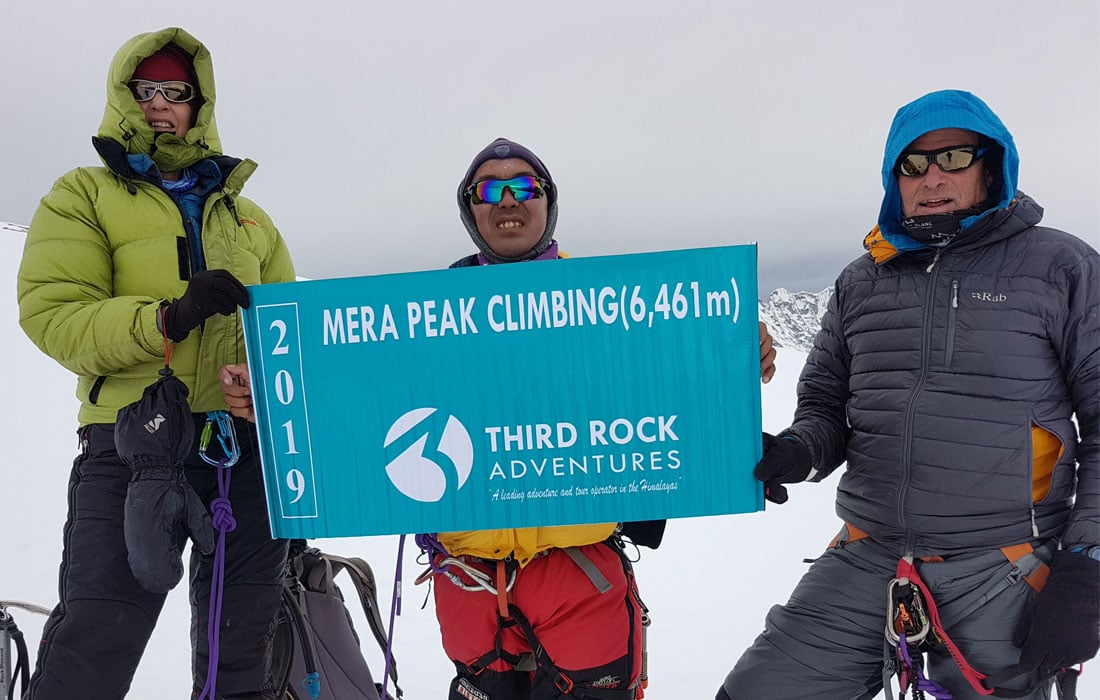






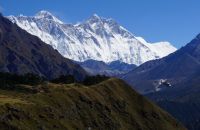
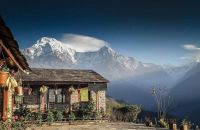
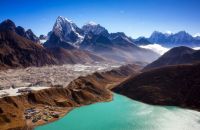
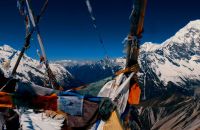
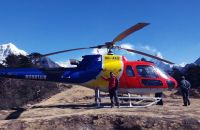
















Recent Comments
All of the topics are excellently covered and if you guys wanna check out how to get the permit then you should check this one: Mera Peak Permit